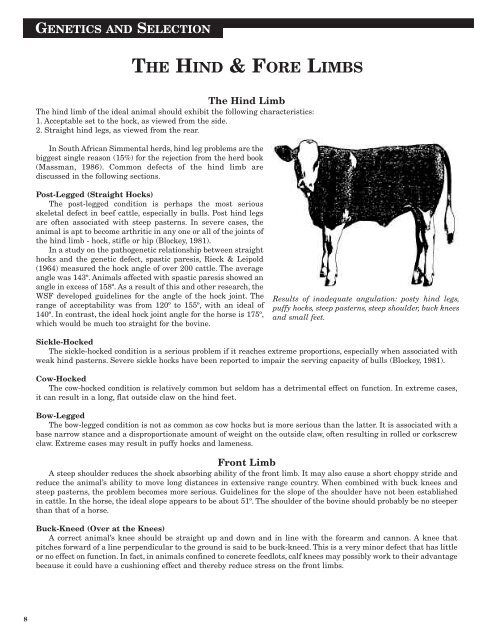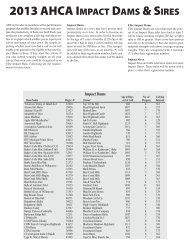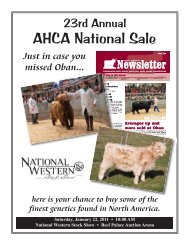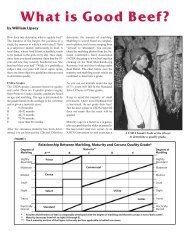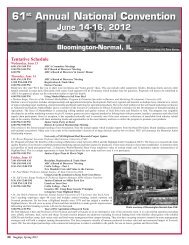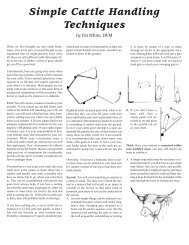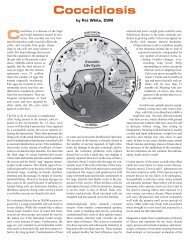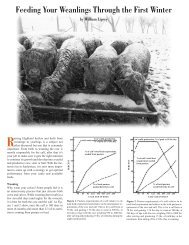The Bagpipe - American Highland Cattle Association
The Bagpipe - American Highland Cattle Association
The Bagpipe - American Highland Cattle Association
Create successful ePaper yourself
Turn your PDF publications into a flip-book with our unique Google optimized e-Paper software.
8<br />
GENETICS AND SELECTION<br />
THE HIND & FORE LIMBS<br />
<strong>The</strong> Hind Limb<br />
<strong>The</strong> hind limb of the ideal animal should exhibit the following characteristics:<br />
1. Acceptable set to the hock, as viewed from the side.<br />
2. Straight hind legs, as viewed from the rear.<br />
In South African Simmental herds, hind leg problems are the<br />
biggest single reason (15%) for the rejection from the herd book<br />
(Massman, 1986). Common defects of the hind limb are<br />
discussed in the following sections.<br />
Post-Legged (Straight Hocks)<br />
<strong>The</strong> post-legged condition is perhaps the most serious<br />
skeletal defect in beef cattle, especially in bulls. Post hind legs<br />
are often associated with steep pasterns. In severe cases, the<br />
animal is apt to become arthritic in any one or all of the joints of<br />
the hind limb - hock, stifle or hip (Blockey, 1981).<br />
In a study on the pathogenetic relationship between straight<br />
hocks and the genetic defect, spastic paresis, Rieck & Leipold<br />
(1964) measured the hock angle of over 200 cattle. <strong>The</strong> average<br />
angle was 143º. Animals affected with spastic paresis showed an<br />
angle in excess of 158º. As a result of this and other research, the<br />
WSF developed guidelines for the angle of the hock joint. <strong>The</strong><br />
range of acceptability was from 120º to 155º, with an ideal of<br />
140º. In contrast, the ideal hock joint angle for the horse is 175º,<br />
which would be much too straight for the bovine.<br />
Results of inadequate angulation: posty hind legs,<br />
puffy hocks, steep pasterns, steep shoulder, buck knees<br />
and small feet.<br />
Sickle-Hocked<br />
<strong>The</strong> sickle-hocked condition is a serious problem if it reaches extreme proportions, especially when associated with<br />
weak hind pasterns. Severe sickle hocks have been reported to impair the serving capacity of bulls (Blockey, 1981).<br />
Cow-Hocked<br />
<strong>The</strong> cow-hocked condition is relatively common but seldom has a detrimental effect on function. In extreme cases,<br />
it can result in a long, flat outside claw on the hind feet.<br />
Bow-Legged<br />
<strong>The</strong> bow-legged condition is not as common as cow hocks but is more serious than the latter. It is associated with a<br />
base narrow stance and a disproportionate amount of weight on the outside claw, often resulting in rolled or corkscrew<br />
claw. Extreme cases may result in puffy hocks and lameness.<br />
Front Limb<br />
A steep shoulder reduces the shock absorbing ability of the front limb. It may also cause a short choppy stride and<br />
reduce the animal’s ability to move long distances in extensive range country. When combined with buck knees and<br />
steep pasterns, the problem becomes more serious. Guidelines for the slope of the shoulder have not been established<br />
in cattle. In the horse, the ideal slope appears to be about 51º. <strong>The</strong> shoulder of the bovine should probably be no steeper<br />
than that of a horse.<br />
Buck-Kneed (Over at the Knees)<br />
A correct animal’s knee should be straight up and down and in line with the forearm and cannon. A knee that<br />
pitches forward of a line perpendicular to the ground is said to be buck-kneed. This is a very minor defect that has little<br />
or no effect on function. In fact, in animals confined to concrete feedlots, calf knees may possibly work to their advantage<br />
because it could have a cushioning effect and thereby reduce stress on the front limbs.


